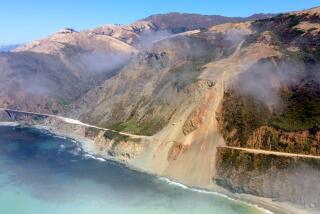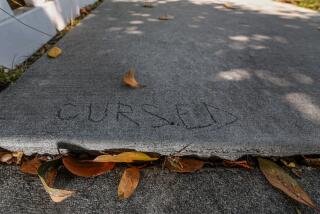Slurry Seal Makes Streets Last Longer
Dear Traffic Talk:
We live on Greenbriar Drive, a residential street in the Tarzana hills.
Recently, we were surprised to see the streets in our neighborhood resurfaced. To be honest, we were shocked because the streets were in fairly good condition and this is the second time in seven years that those streets have been resurfaced.
Meanwhile, Wells Drive between Vanalden Street and Reseda Boulevard--a busy thoroughfare and shortcut in our community--is a mess and has not been resurfaced in more than 10 years. I remember reading that it was scheduled to be repaved in 1994.
Why are some streets within the same community, regardless of their condition, resurfaced more often than others?
Oren Peretz
Tarzana
Dear Oren:
Greenbriar was, indeed, resurfaced in 1990. The most recent work, however, was not repaving.
Rather, the street was slurry sealed, a process that follows some years after the actual repair work, said Gary Gsell of the city’s Bureau of Street Maintenance.
Optimally, slurry sealing should follow three years after the repaving, Gsell said.
He said the process replaces eroded fine aggregate particles, seals minor cracks and provides an approximately 1/8-inch to 3/8-inch wearing surface that lasts about seven years.
Slurry seal is applied to residential streets with good riding and drainage qualities to keep them in a perpetual good to excellent condition, authorities said.
A maximum of three slurry seals can be applied to a street that has been resurfaced. That extends their serviceability by 21 years, Gsell said.
Ordinarily, streets throughout the city are rated by the bureau’s Pavement Management System and placed on the bureau’s slurry seal program. The criteria include a requirement that the streets have a good ride and no extensive cracking.
As for Wells Drive, it is still on the Bureau of Engineering’s 1993-94 Capital Improvement Program, Gsell said.
Although streets are sometimes placed on the repair schedule, the work is sometimes not carried out on time for various reasons, including lack of funds.
More information about the Wells Drive project is available by calling the Bureau of Engineering’s Valley Division at (818) 756-8457.
Dear Traffic Talk:
I take the westbound Foothill Freeway to the westbound Ronald Reagan Freeway, where there is a big space at the exchange.
It truly scares me and I am happy I don’t have to take that route more frequently. Isn’t it dangerous?
Betty FitzGerald
La Crescenta
Dear Betty:
There is some extra space on the bridge at that junction in anticipation of increased traffic.
Presently, there are two lanes clearly marked on the connector road from the westbound Foothill Freeway onto the westbound Ronald Reagan Freeway. Motorists should drive within the markings.
The westbound Ronald Reagan Freeway connector on the bridge was designed and built for three lanes, said Pat Reid, a Caltrans spokeswoman.
Although only two of the lanes are now being used, engineers could install a third lane in the extra space for increased traffic.
Traffic Talk appears Fridays in The Times Valley Edition. Readers may submit comments and questions about traffic in the Valley to Traffic Talk, Los Angeles Times, 20000 Prairie St., Chatsworth 91311. Include your name, address and phone number. Letters may be edited, and no anonymous letters will be accepted. To record your comments, call (818) 772-3303. Fax letters to (818) 772-3385. E-mail questions to valley@latimes.com
More to Read
Sign up for Essential California
The most important California stories and recommendations in your inbox every morning.
You may occasionally receive promotional content from the Los Angeles Times.










